Breast Cancer: Health Issues, Determinants, and Healthcare Services
VerifiedAdded on 2021/06/15
|9
|1860
|163
Report
AI Summary
This report examines a case study of a 45-year-old woman diagnosed with early-stage breast cancer, focusing on the health issues, social, and environmental determinants influencing her condition. The study highlights the alarming statistics of breast cancer in Australia, its impact on quality of life, and the psychological effects on patients. It explores the social myths and behaviors contributing to cancer development, such as smoking, alcohol consumption, and lack of awareness. The report then describes the Australian healthcare system's services, particularly those offered by the South West Sydney Local Healthcare district, including fast-track cancer care pathways and multidisciplinary teams. It critiques these services, addressing disparities in healthcare access and communication gaps. The report concludes with recommendations to improve healthcare delivery, such as recruiting more specialists and expanding community-based health education programs.
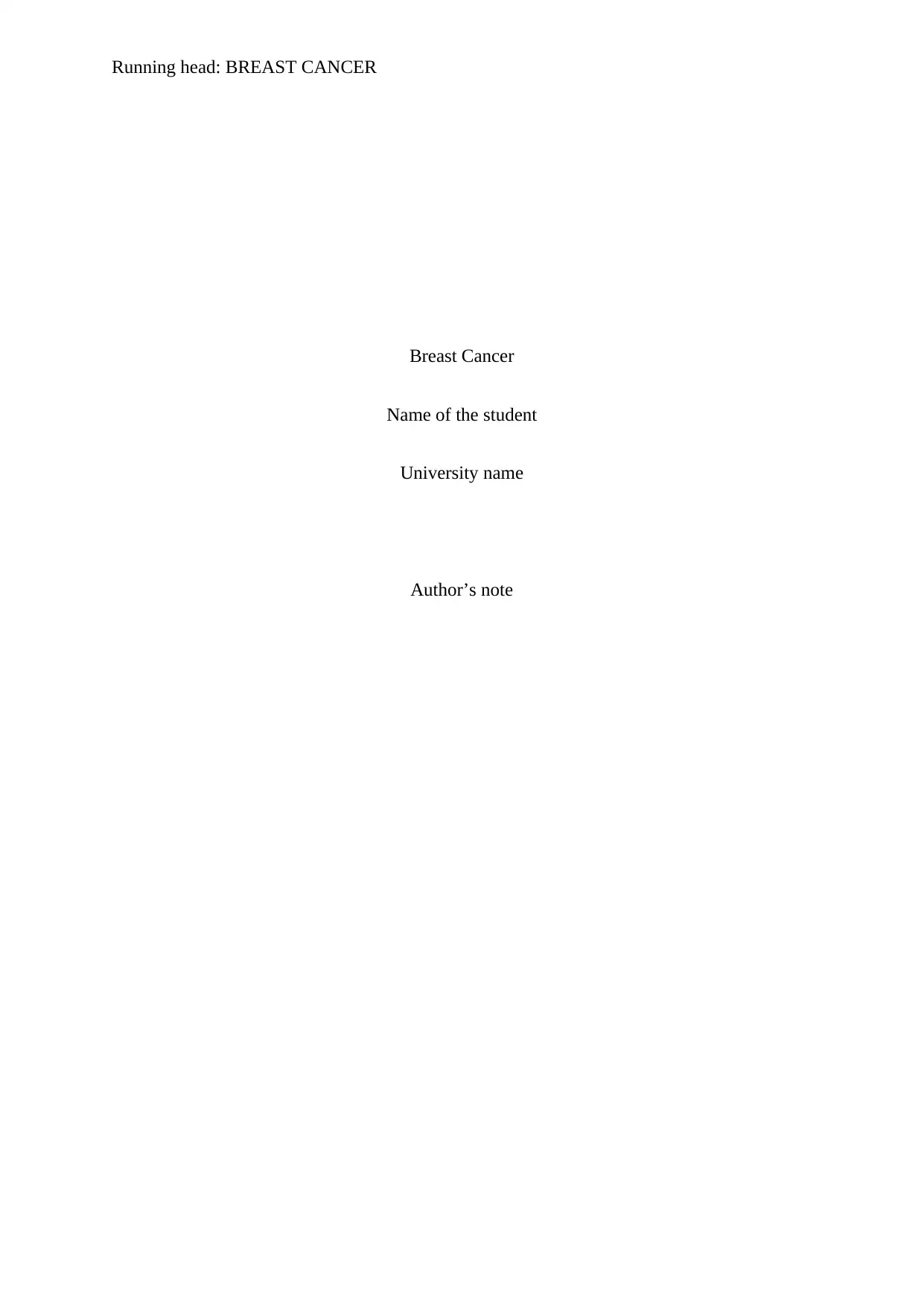
Running head: BREAST CANCER
Breast Cancer
Name of the student
University name
Author’s note
Breast Cancer
Name of the student
University name
Author’s note
Paraphrase This Document
Need a fresh take? Get an instant paraphrase of this document with our AI Paraphraser
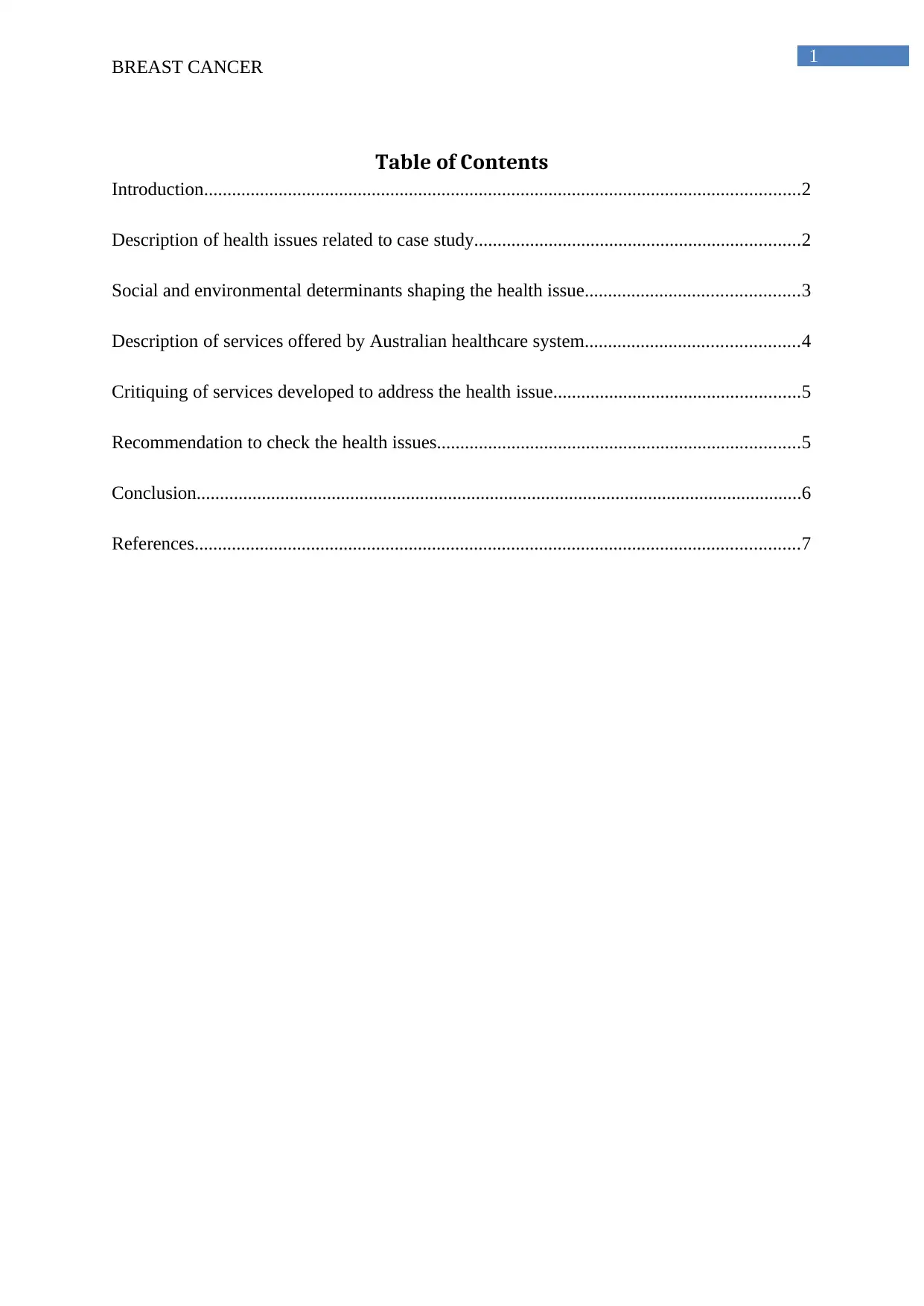
1
BREAST CANCER
Table of Contents
Introduction................................................................................................................................2
Description of health issues related to case study......................................................................2
Social and environmental determinants shaping the health issue..............................................3
Description of services offered by Australian healthcare system..............................................4
Critiquing of services developed to address the health issue.....................................................5
Recommendation to check the health issues..............................................................................5
Conclusion..................................................................................................................................6
References..................................................................................................................................7
BREAST CANCER
Table of Contents
Introduction................................................................................................................................2
Description of health issues related to case study......................................................................2
Social and environmental determinants shaping the health issue..............................................3
Description of services offered by Australian healthcare system..............................................4
Critiquing of services developed to address the health issue.....................................................5
Recommendation to check the health issues..............................................................................5
Conclusion..................................................................................................................................6
References..................................................................................................................................7
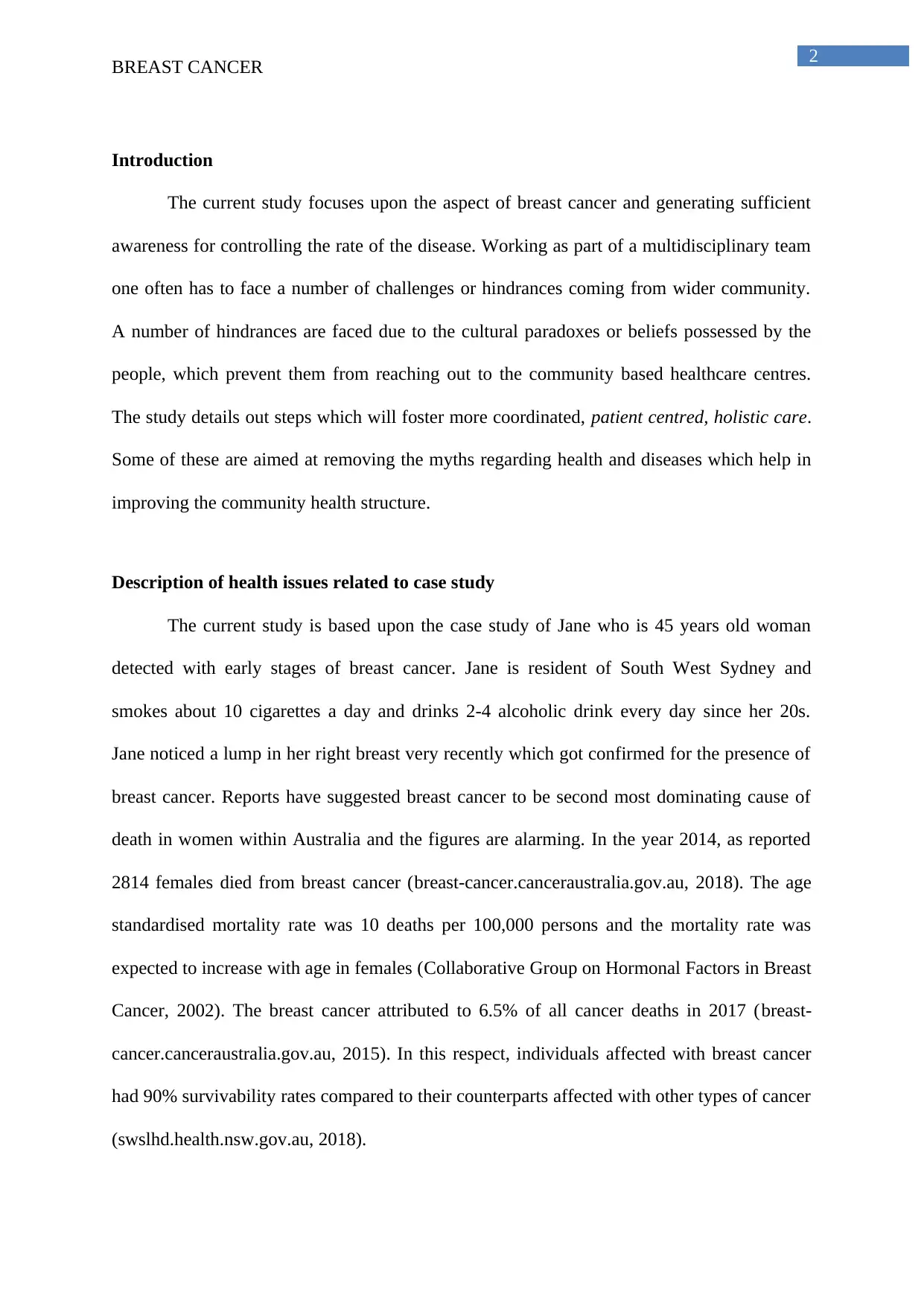
2
BREAST CANCER
Introduction
The current study focuses upon the aspect of breast cancer and generating sufficient
awareness for controlling the rate of the disease. Working as part of a multidisciplinary team
one often has to face a number of challenges or hindrances coming from wider community.
A number of hindrances are faced due to the cultural paradoxes or beliefs possessed by the
people, which prevent them from reaching out to the community based healthcare centres.
The study details out steps which will foster more coordinated, patient centred, holistic care.
Some of these are aimed at removing the myths regarding health and diseases which help in
improving the community health structure.
Description of health issues related to case study
The current study is based upon the case study of Jane who is 45 years old woman
detected with early stages of breast cancer. Jane is resident of South West Sydney and
smokes about 10 cigarettes a day and drinks 2-4 alcoholic drink every day since her 20s.
Jane noticed a lump in her right breast very recently which got confirmed for the presence of
breast cancer. Reports have suggested breast cancer to be second most dominating cause of
death in women within Australia and the figures are alarming. In the year 2014, as reported
2814 females died from breast cancer (breast-cancer.canceraustralia.gov.au, 2018). The age
standardised mortality rate was 10 deaths per 100,000 persons and the mortality rate was
expected to increase with age in females (Collaborative Group on Hormonal Factors in Breast
Cancer, 2002). The breast cancer attributed to 6.5% of all cancer deaths in 2017 (breast-
cancer.canceraustralia.gov.au, 2015). In this respect, individuals affected with breast cancer
had 90% survivability rates compared to their counterparts affected with other types of cancer
(swslhd.health.nsw.gov.au, 2018).
BREAST CANCER
Introduction
The current study focuses upon the aspect of breast cancer and generating sufficient
awareness for controlling the rate of the disease. Working as part of a multidisciplinary team
one often has to face a number of challenges or hindrances coming from wider community.
A number of hindrances are faced due to the cultural paradoxes or beliefs possessed by the
people, which prevent them from reaching out to the community based healthcare centres.
The study details out steps which will foster more coordinated, patient centred, holistic care.
Some of these are aimed at removing the myths regarding health and diseases which help in
improving the community health structure.
Description of health issues related to case study
The current study is based upon the case study of Jane who is 45 years old woman
detected with early stages of breast cancer. Jane is resident of South West Sydney and
smokes about 10 cigarettes a day and drinks 2-4 alcoholic drink every day since her 20s.
Jane noticed a lump in her right breast very recently which got confirmed for the presence of
breast cancer. Reports have suggested breast cancer to be second most dominating cause of
death in women within Australia and the figures are alarming. In the year 2014, as reported
2814 females died from breast cancer (breast-cancer.canceraustralia.gov.au, 2018). The age
standardised mortality rate was 10 deaths per 100,000 persons and the mortality rate was
expected to increase with age in females (Collaborative Group on Hormonal Factors in Breast
Cancer, 2002). The breast cancer attributed to 6.5% of all cancer deaths in 2017 (breast-
cancer.canceraustralia.gov.au, 2015). In this respect, individuals affected with breast cancer
had 90% survivability rates compared to their counterparts affected with other types of cancer
(swslhd.health.nsw.gov.au, 2018).
⊘ This is a preview!⊘
Do you want full access?
Subscribe today to unlock all pages.

Trusted by 1+ million students worldwide
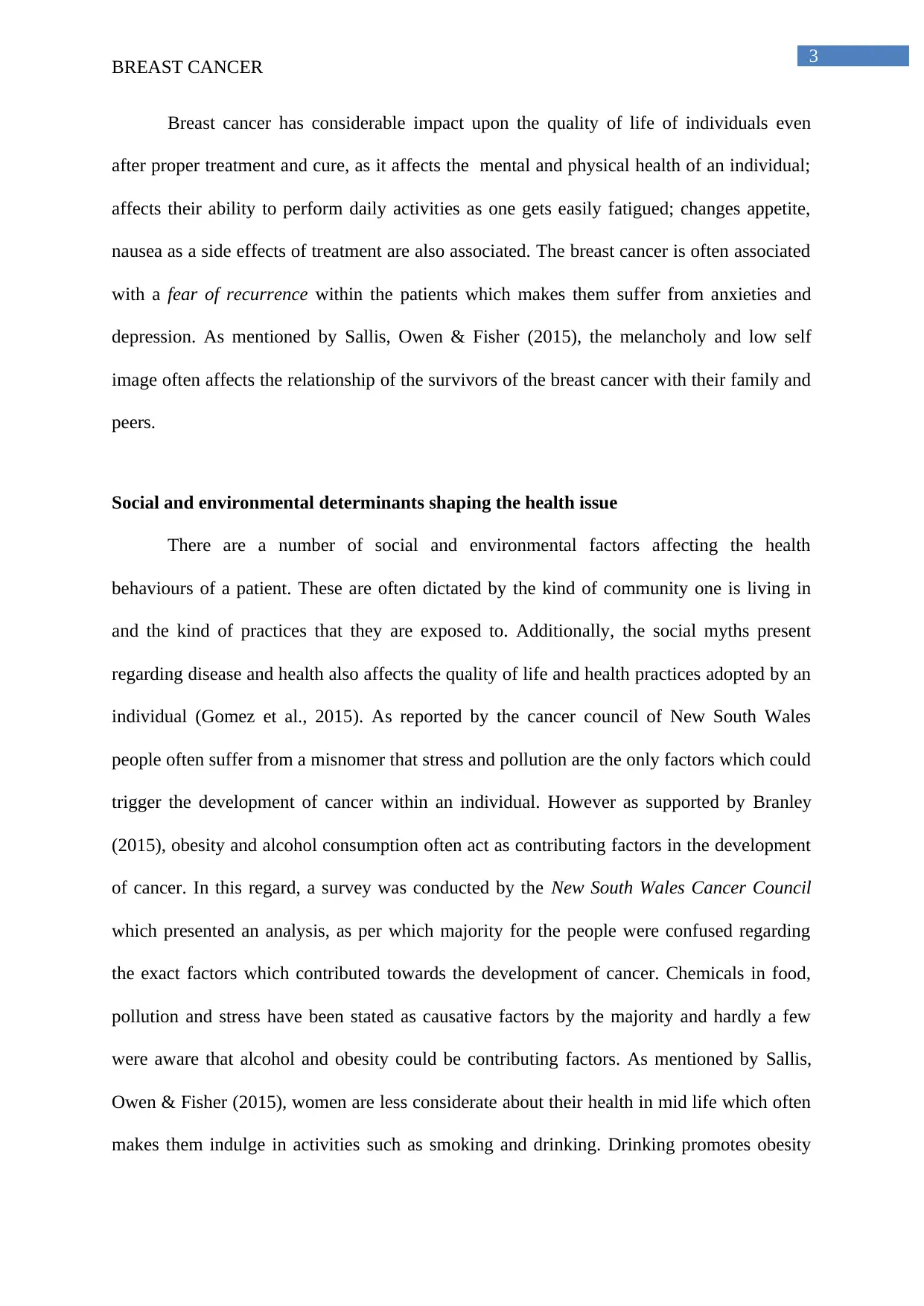
3
BREAST CANCER
Breast cancer has considerable impact upon the quality of life of individuals even
after proper treatment and cure, as it affects the mental and physical health of an individual;
affects their ability to perform daily activities as one gets easily fatigued; changes appetite,
nausea as a side effects of treatment are also associated. The breast cancer is often associated
with a fear of recurrence within the patients which makes them suffer from anxieties and
depression. As mentioned by Sallis, Owen & Fisher (2015), the melancholy and low self
image often affects the relationship of the survivors of the breast cancer with their family and
peers.
Social and environmental determinants shaping the health issue
There are a number of social and environmental factors affecting the health
behaviours of a patient. These are often dictated by the kind of community one is living in
and the kind of practices that they are exposed to. Additionally, the social myths present
regarding disease and health also affects the quality of life and health practices adopted by an
individual (Gomez et al., 2015). As reported by the cancer council of New South Wales
people often suffer from a misnomer that stress and pollution are the only factors which could
trigger the development of cancer within an individual. However as supported by Branley
(2015), obesity and alcohol consumption often act as contributing factors in the development
of cancer. In this regard, a survey was conducted by the New South Wales Cancer Council
which presented an analysis, as per which majority for the people were confused regarding
the exact factors which contributed towards the development of cancer. Chemicals in food,
pollution and stress have been stated as causative factors by the majority and hardly a few
were aware that alcohol and obesity could be contributing factors. As mentioned by Sallis,
Owen & Fisher (2015), women are less considerate about their health in mid life which often
makes them indulge in activities such as smoking and drinking. Drinking promotes obesity
BREAST CANCER
Breast cancer has considerable impact upon the quality of life of individuals even
after proper treatment and cure, as it affects the mental and physical health of an individual;
affects their ability to perform daily activities as one gets easily fatigued; changes appetite,
nausea as a side effects of treatment are also associated. The breast cancer is often associated
with a fear of recurrence within the patients which makes them suffer from anxieties and
depression. As mentioned by Sallis, Owen & Fisher (2015), the melancholy and low self
image often affects the relationship of the survivors of the breast cancer with their family and
peers.
Social and environmental determinants shaping the health issue
There are a number of social and environmental factors affecting the health
behaviours of a patient. These are often dictated by the kind of community one is living in
and the kind of practices that they are exposed to. Additionally, the social myths present
regarding disease and health also affects the quality of life and health practices adopted by an
individual (Gomez et al., 2015). As reported by the cancer council of New South Wales
people often suffer from a misnomer that stress and pollution are the only factors which could
trigger the development of cancer within an individual. However as supported by Branley
(2015), obesity and alcohol consumption often act as contributing factors in the development
of cancer. In this regard, a survey was conducted by the New South Wales Cancer Council
which presented an analysis, as per which majority for the people were confused regarding
the exact factors which contributed towards the development of cancer. Chemicals in food,
pollution and stress have been stated as causative factors by the majority and hardly a few
were aware that alcohol and obesity could be contributing factors. As mentioned by Sallis,
Owen & Fisher (2015), women are less considerate about their health in mid life which often
makes them indulge in activities such as smoking and drinking. Drinking promotes obesity
Paraphrase This Document
Need a fresh take? Get an instant paraphrase of this document with our AI Paraphraser
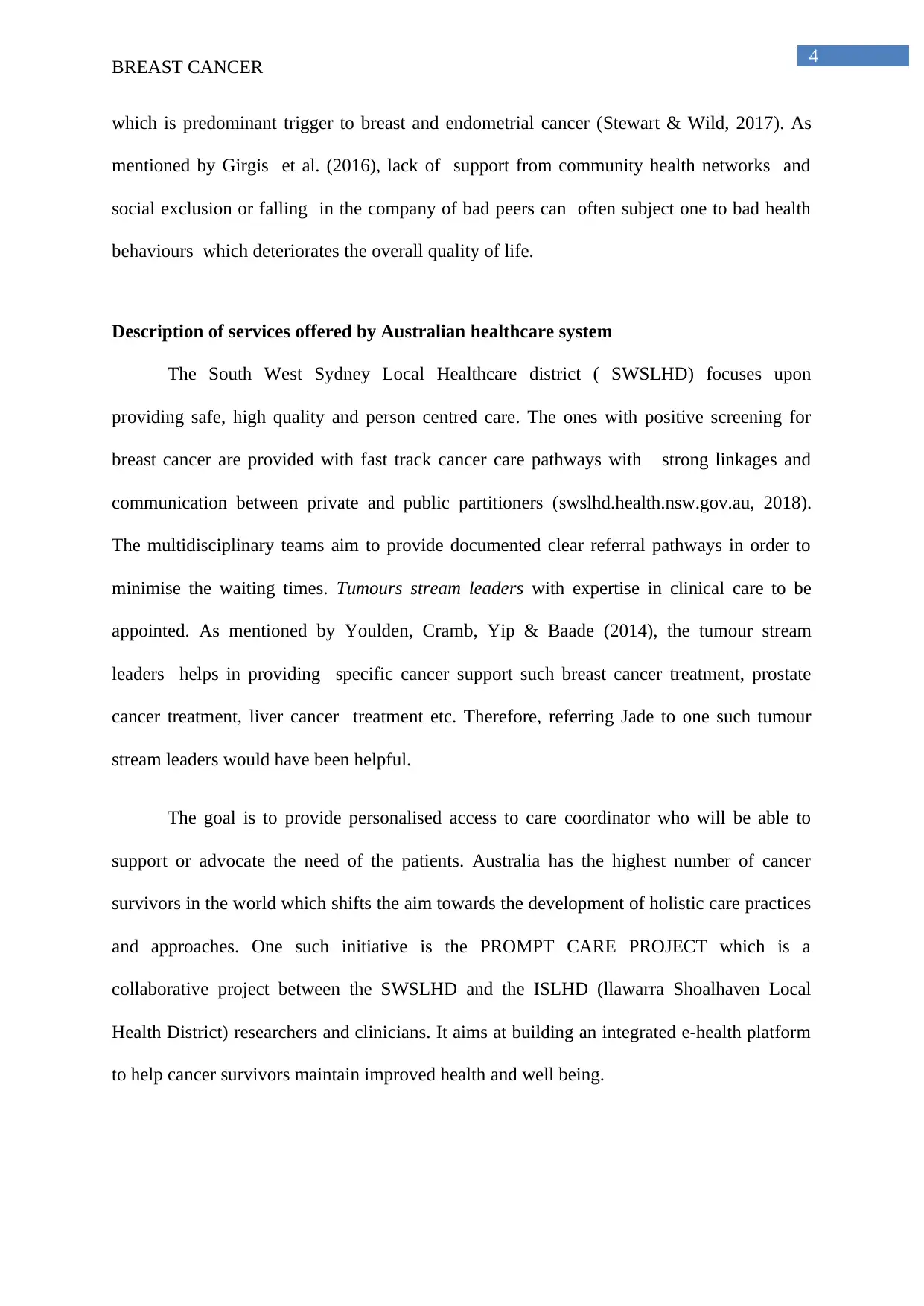
4
BREAST CANCER
which is predominant trigger to breast and endometrial cancer (Stewart & Wild, 2017). As
mentioned by Girgis et al. (2016), lack of support from community health networks and
social exclusion or falling in the company of bad peers can often subject one to bad health
behaviours which deteriorates the overall quality of life.
Description of services offered by Australian healthcare system
The South West Sydney Local Healthcare district ( SWSLHD) focuses upon
providing safe, high quality and person centred care. The ones with positive screening for
breast cancer are provided with fast track cancer care pathways with strong linkages and
communication between private and public partitioners (swslhd.health.nsw.gov.au, 2018).
The multidisciplinary teams aim to provide documented clear referral pathways in order to
minimise the waiting times. Tumours stream leaders with expertise in clinical care to be
appointed. As mentioned by Youlden, Cramb, Yip & Baade (2014), the tumour stream
leaders helps in providing specific cancer support such breast cancer treatment, prostate
cancer treatment, liver cancer treatment etc. Therefore, referring Jade to one such tumour
stream leaders would have been helpful.
The goal is to provide personalised access to care coordinator who will be able to
support or advocate the need of the patients. Australia has the highest number of cancer
survivors in the world which shifts the aim towards the development of holistic care practices
and approaches. One such initiative is the PROMPT CARE PROJECT which is a
collaborative project between the SWSLHD and the ISLHD (llawarra Shoalhaven Local
Health District) researchers and clinicians. It aims at building an integrated e-health platform
to help cancer survivors maintain improved health and well being.
BREAST CANCER
which is predominant trigger to breast and endometrial cancer (Stewart & Wild, 2017). As
mentioned by Girgis et al. (2016), lack of support from community health networks and
social exclusion or falling in the company of bad peers can often subject one to bad health
behaviours which deteriorates the overall quality of life.
Description of services offered by Australian healthcare system
The South West Sydney Local Healthcare district ( SWSLHD) focuses upon
providing safe, high quality and person centred care. The ones with positive screening for
breast cancer are provided with fast track cancer care pathways with strong linkages and
communication between private and public partitioners (swslhd.health.nsw.gov.au, 2018).
The multidisciplinary teams aim to provide documented clear referral pathways in order to
minimise the waiting times. Tumours stream leaders with expertise in clinical care to be
appointed. As mentioned by Youlden, Cramb, Yip & Baade (2014), the tumour stream
leaders helps in providing specific cancer support such breast cancer treatment, prostate
cancer treatment, liver cancer treatment etc. Therefore, referring Jade to one such tumour
stream leaders would have been helpful.
The goal is to provide personalised access to care coordinator who will be able to
support or advocate the need of the patients. Australia has the highest number of cancer
survivors in the world which shifts the aim towards the development of holistic care practices
and approaches. One such initiative is the PROMPT CARE PROJECT which is a
collaborative project between the SWSLHD and the ISLHD (llawarra Shoalhaven Local
Health District) researchers and clinicians. It aims at building an integrated e-health platform
to help cancer survivors maintain improved health and well being.
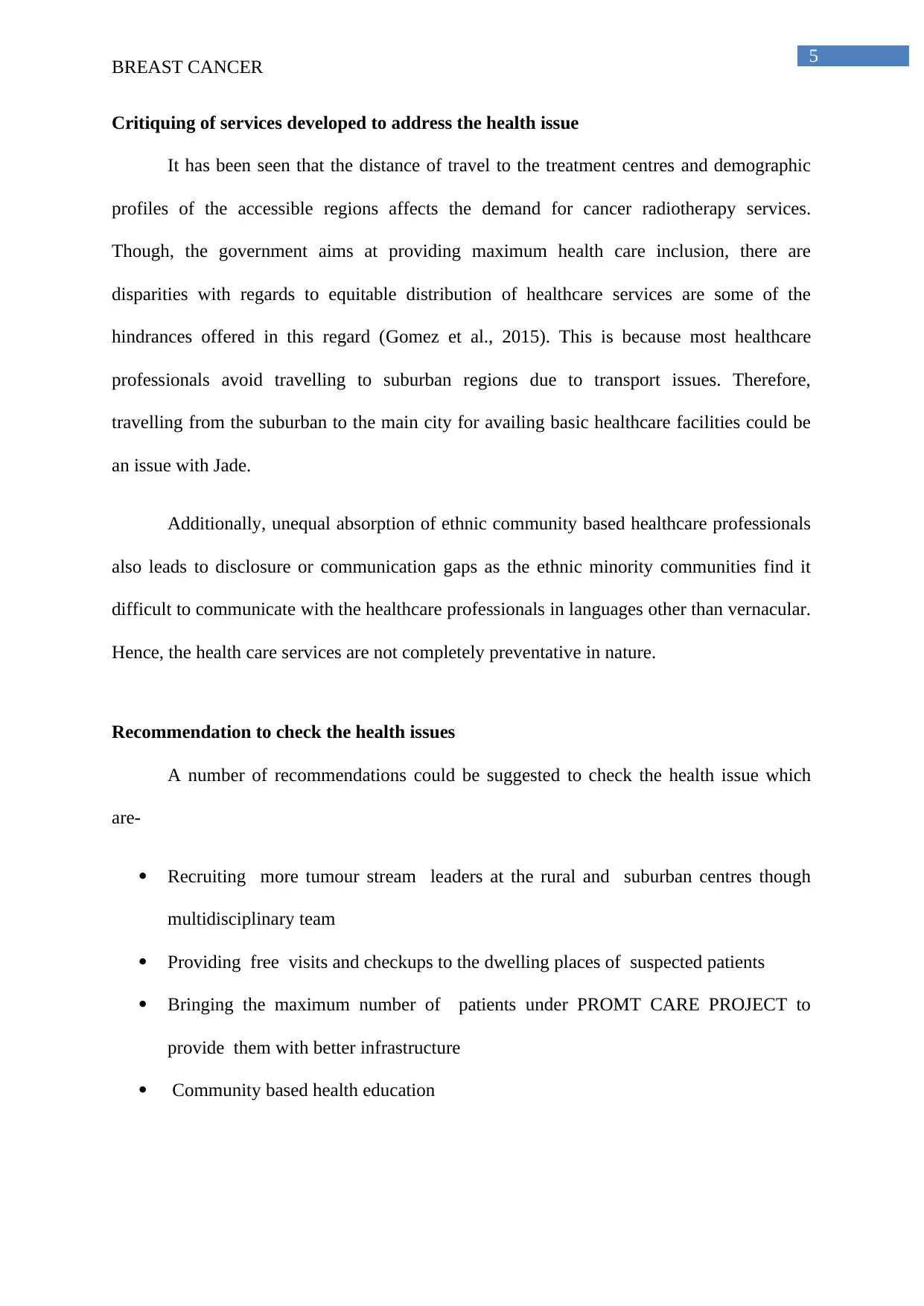
5
BREAST CANCER
Critiquing of services developed to address the health issue
It has been seen that the distance of travel to the treatment centres and demographic
profiles of the accessible regions affects the demand for cancer radiotherapy services.
Though, the government aims at providing maximum health care inclusion, there are
disparities with regards to equitable distribution of healthcare services are some of the
hindrances offered in this regard (Gomez et al., 2015). This is because most healthcare
professionals avoid travelling to suburban regions due to transport issues. Therefore,
travelling from the suburban to the main city for availing basic healthcare facilities could be
an issue with Jade.
Additionally, unequal absorption of ethnic community based healthcare professionals
also leads to disclosure or communication gaps as the ethnic minority communities find it
difficult to communicate with the healthcare professionals in languages other than vernacular.
Hence, the health care services are not completely preventative in nature.
Recommendation to check the health issues
A number of recommendations could be suggested to check the health issue which
are-
Recruiting more tumour stream leaders at the rural and suburban centres though
multidisciplinary team
Providing free visits and checkups to the dwelling places of suspected patients
Bringing the maximum number of patients under PROMT CARE PROJECT to
provide them with better infrastructure
Community based health education
BREAST CANCER
Critiquing of services developed to address the health issue
It has been seen that the distance of travel to the treatment centres and demographic
profiles of the accessible regions affects the demand for cancer radiotherapy services.
Though, the government aims at providing maximum health care inclusion, there are
disparities with regards to equitable distribution of healthcare services are some of the
hindrances offered in this regard (Gomez et al., 2015). This is because most healthcare
professionals avoid travelling to suburban regions due to transport issues. Therefore,
travelling from the suburban to the main city for availing basic healthcare facilities could be
an issue with Jade.
Additionally, unequal absorption of ethnic community based healthcare professionals
also leads to disclosure or communication gaps as the ethnic minority communities find it
difficult to communicate with the healthcare professionals in languages other than vernacular.
Hence, the health care services are not completely preventative in nature.
Recommendation to check the health issues
A number of recommendations could be suggested to check the health issue which
are-
Recruiting more tumour stream leaders at the rural and suburban centres though
multidisciplinary team
Providing free visits and checkups to the dwelling places of suspected patients
Bringing the maximum number of patients under PROMT CARE PROJECT to
provide them with better infrastructure
Community based health education
⊘ This is a preview!⊘
Do you want full access?
Subscribe today to unlock all pages.

Trusted by 1+ million students worldwide
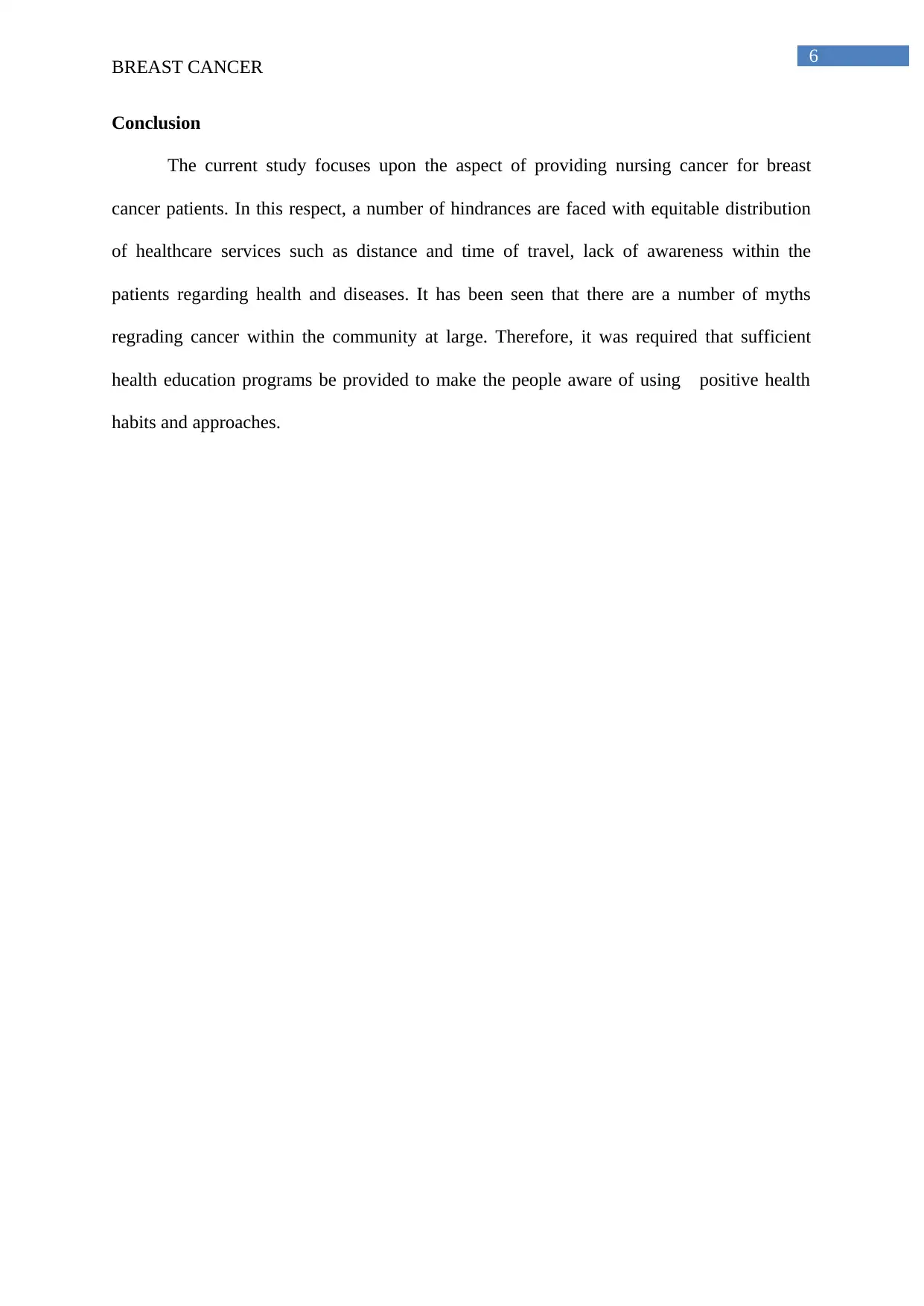
6
BREAST CANCER
Conclusion
The current study focuses upon the aspect of providing nursing cancer for breast
cancer patients. In this respect, a number of hindrances are faced with equitable distribution
of healthcare services such as distance and time of travel, lack of awareness within the
patients regarding health and diseases. It has been seen that there are a number of myths
regrading cancer within the community at large. Therefore, it was required that sufficient
health education programs be provided to make the people aware of using positive health
habits and approaches.
BREAST CANCER
Conclusion
The current study focuses upon the aspect of providing nursing cancer for breast
cancer patients. In this respect, a number of hindrances are faced with equitable distribution
of healthcare services such as distance and time of travel, lack of awareness within the
patients regarding health and diseases. It has been seen that there are a number of myths
regrading cancer within the community at large. Therefore, it was required that sufficient
health education programs be provided to make the people aware of using positive health
habits and approaches.
Paraphrase This Document
Need a fresh take? Get an instant paraphrase of this document with our AI Paraphraser
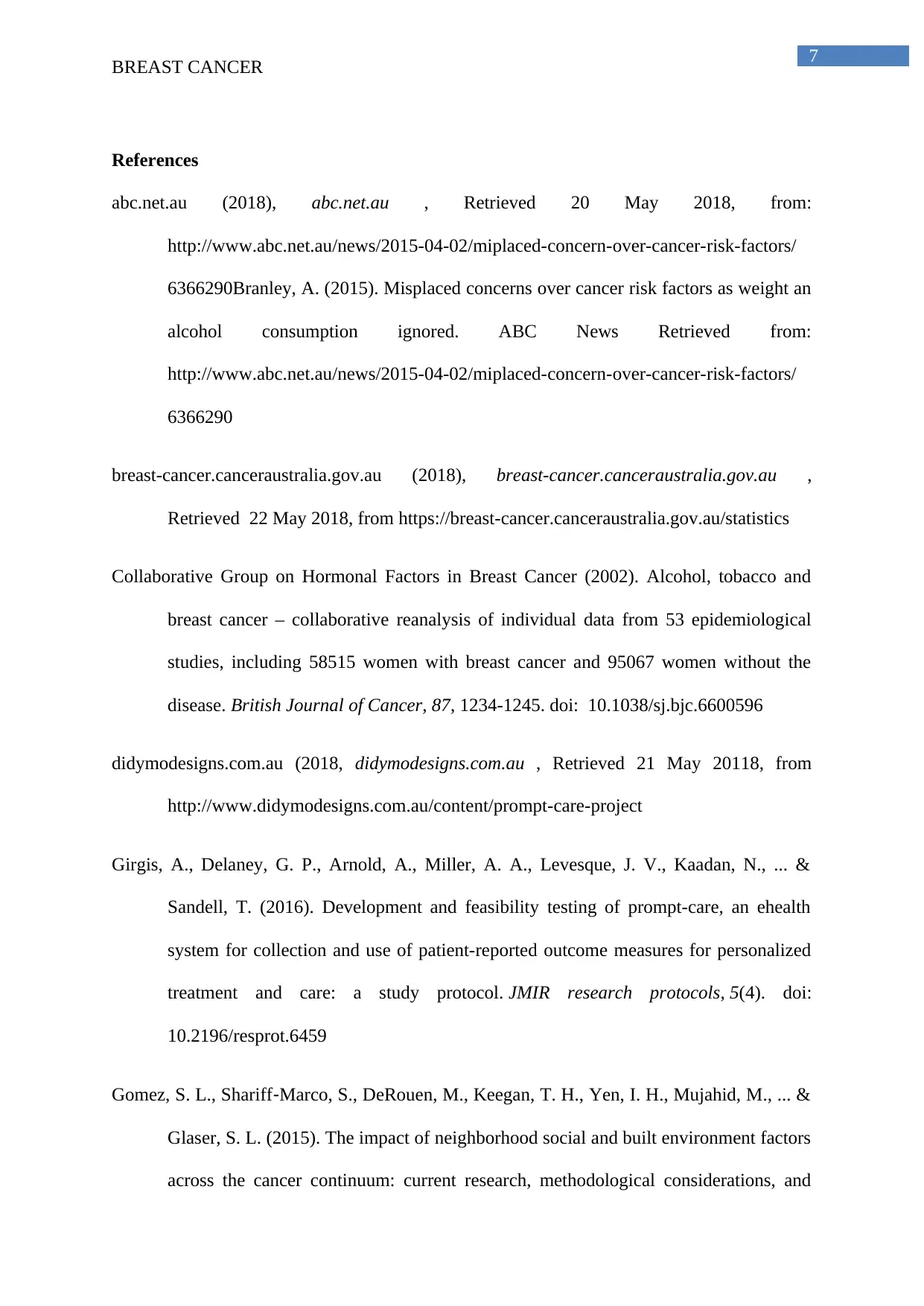
7
BREAST CANCER
References
abc.net.au (2018), abc.net.au , Retrieved 20 May 2018, from:
http://www.abc.net.au/news/2015-04-02/miplaced-concern-over-cancer-risk-factors/
6366290Branley, A. (2015). Misplaced concerns over cancer risk factors as weight an
alcohol consumption ignored. ABC News Retrieved from:
http://www.abc.net.au/news/2015-04-02/miplaced-concern-over-cancer-risk-factors/
6366290
breast-cancer.canceraustralia.gov.au (2018), breast-cancer.canceraustralia.gov.au ,
Retrieved 22 May 2018, from https://breast-cancer.canceraustralia.gov.au/statistics
Collaborative Group on Hormonal Factors in Breast Cancer (2002). Alcohol, tobacco and
breast cancer – collaborative reanalysis of individual data from 53 epidemiological
studies, including 58515 women with breast cancer and 95067 women without the
disease. British Journal of Cancer, 87, 1234-1245. doi: 10.1038/sj.bjc.6600596
didymodesigns.com.au (2018, didymodesigns.com.au , Retrieved 21 May 20118, from
http://www.didymodesigns.com.au/content/prompt-care-project
Girgis, A., Delaney, G. P., Arnold, A., Miller, A. A., Levesque, J. V., Kaadan, N., ... &
Sandell, T. (2016). Development and feasibility testing of prompt-care, an ehealth
system for collection and use of patient-reported outcome measures for personalized
treatment and care: a study protocol. JMIR research protocols, 5(4). doi:
10.2196/resprot.6459
Gomez, S. L., Shariff‐Marco, S., DeRouen, M., Keegan, T. H., Yen, I. H., Mujahid, M., ... &
Glaser, S. L. (2015). The impact of neighborhood social and built environment factors
across the cancer continuum: current research, methodological considerations, and
BREAST CANCER
References
abc.net.au (2018), abc.net.au , Retrieved 20 May 2018, from:
http://www.abc.net.au/news/2015-04-02/miplaced-concern-over-cancer-risk-factors/
6366290Branley, A. (2015). Misplaced concerns over cancer risk factors as weight an
alcohol consumption ignored. ABC News Retrieved from:
http://www.abc.net.au/news/2015-04-02/miplaced-concern-over-cancer-risk-factors/
6366290
breast-cancer.canceraustralia.gov.au (2018), breast-cancer.canceraustralia.gov.au ,
Retrieved 22 May 2018, from https://breast-cancer.canceraustralia.gov.au/statistics
Collaborative Group on Hormonal Factors in Breast Cancer (2002). Alcohol, tobacco and
breast cancer – collaborative reanalysis of individual data from 53 epidemiological
studies, including 58515 women with breast cancer and 95067 women without the
disease. British Journal of Cancer, 87, 1234-1245. doi: 10.1038/sj.bjc.6600596
didymodesigns.com.au (2018, didymodesigns.com.au , Retrieved 21 May 20118, from
http://www.didymodesigns.com.au/content/prompt-care-project
Girgis, A., Delaney, G. P., Arnold, A., Miller, A. A., Levesque, J. V., Kaadan, N., ... &
Sandell, T. (2016). Development and feasibility testing of prompt-care, an ehealth
system for collection and use of patient-reported outcome measures for personalized
treatment and care: a study protocol. JMIR research protocols, 5(4). doi:
10.2196/resprot.6459
Gomez, S. L., Shariff‐Marco, S., DeRouen, M., Keegan, T. H., Yen, I. H., Mujahid, M., ... &
Glaser, S. L. (2015). The impact of neighborhood social and built environment factors
across the cancer continuum: current research, methodological considerations, and
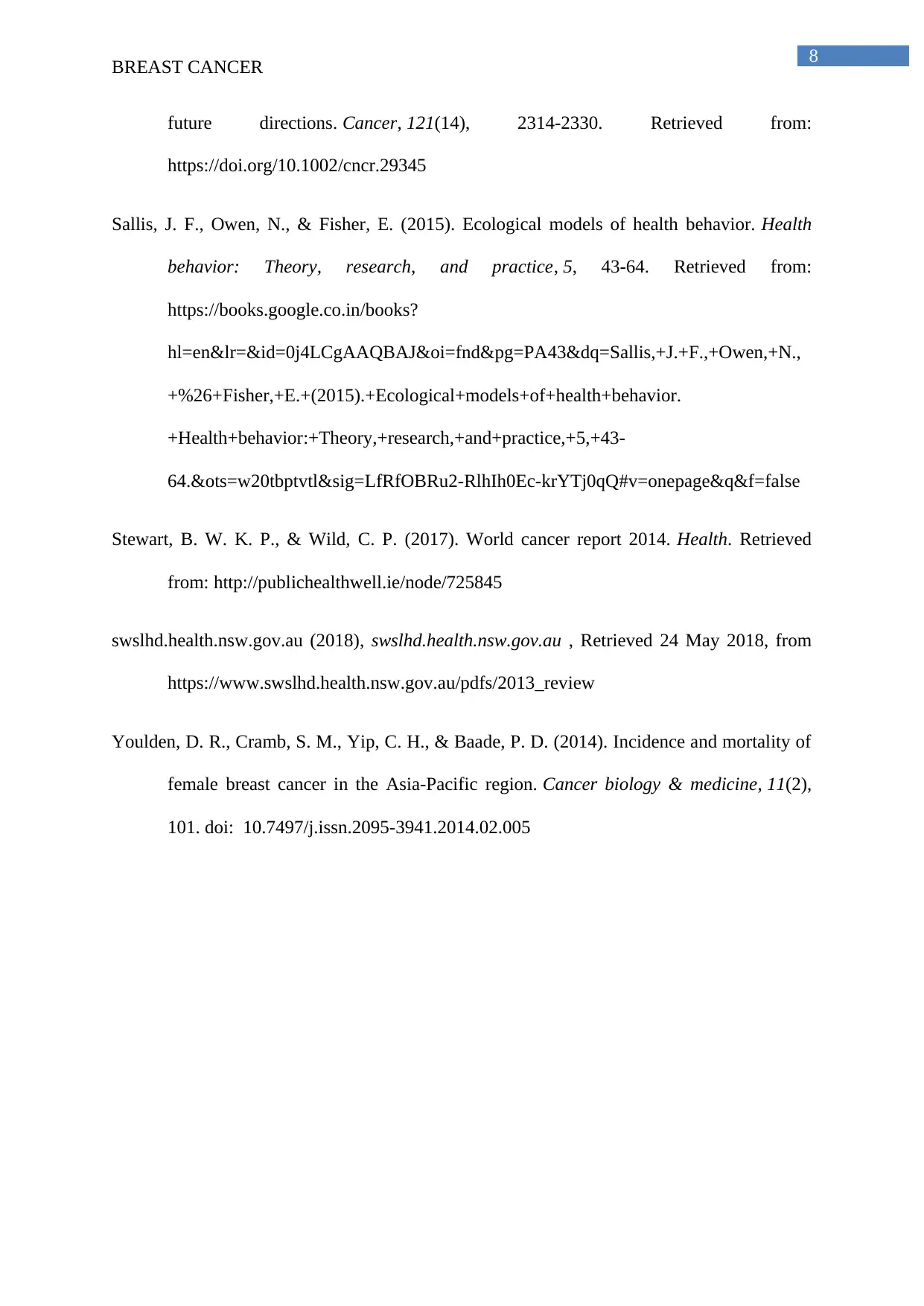
8
BREAST CANCER
future directions. Cancer, 121(14), 2314-2330. Retrieved from:
https://doi.org/10.1002/cncr.29345
Sallis, J. F., Owen, N., & Fisher, E. (2015). Ecological models of health behavior. Health
behavior: Theory, research, and practice, 5, 43-64. Retrieved from:
https://books.google.co.in/books?
hl=en&lr=&id=0j4LCgAAQBAJ&oi=fnd&pg=PA43&dq=Sallis,+J.+F.,+Owen,+N.,
+%26+Fisher,+E.+(2015).+Ecological+models+of+health+behavior.
+Health+behavior:+Theory,+research,+and+practice,+5,+43-
64.&ots=w20tbptvtl&sig=LfRfOBRu2-RlhIh0Ec-krYTj0qQ#v=onepage&q&f=false
Stewart, B. W. K. P., & Wild, C. P. (2017). World cancer report 2014. Health. Retrieved
from: http://publichealthwell.ie/node/725845
swslhd.health.nsw.gov.au (2018), swslhd.health.nsw.gov.au , Retrieved 24 May 2018, from
https://www.swslhd.health.nsw.gov.au/pdfs/2013_review
Youlden, D. R., Cramb, S. M., Yip, C. H., & Baade, P. D. (2014). Incidence and mortality of
female breast cancer in the Asia-Pacific region. Cancer biology & medicine, 11(2),
101. doi: 10.7497/j.issn.2095-3941.2014.02.005
BREAST CANCER
future directions. Cancer, 121(14), 2314-2330. Retrieved from:
https://doi.org/10.1002/cncr.29345
Sallis, J. F., Owen, N., & Fisher, E. (2015). Ecological models of health behavior. Health
behavior: Theory, research, and practice, 5, 43-64. Retrieved from:
https://books.google.co.in/books?
hl=en&lr=&id=0j4LCgAAQBAJ&oi=fnd&pg=PA43&dq=Sallis,+J.+F.,+Owen,+N.,
+%26+Fisher,+E.+(2015).+Ecological+models+of+health+behavior.
+Health+behavior:+Theory,+research,+and+practice,+5,+43-
64.&ots=w20tbptvtl&sig=LfRfOBRu2-RlhIh0Ec-krYTj0qQ#v=onepage&q&f=false
Stewart, B. W. K. P., & Wild, C. P. (2017). World cancer report 2014. Health. Retrieved
from: http://publichealthwell.ie/node/725845
swslhd.health.nsw.gov.au (2018), swslhd.health.nsw.gov.au , Retrieved 24 May 2018, from
https://www.swslhd.health.nsw.gov.au/pdfs/2013_review
Youlden, D. R., Cramb, S. M., Yip, C. H., & Baade, P. D. (2014). Incidence and mortality of
female breast cancer in the Asia-Pacific region. Cancer biology & medicine, 11(2),
101. doi: 10.7497/j.issn.2095-3941.2014.02.005
⊘ This is a preview!⊘
Do you want full access?
Subscribe today to unlock all pages.

Trusted by 1+ million students worldwide
1 out of 9
Related Documents
Your All-in-One AI-Powered Toolkit for Academic Success.
+13062052269
info@desklib.com
Available 24*7 on WhatsApp / Email
![[object Object]](/_next/static/media/star-bottom.7253800d.svg)
Unlock your academic potential
Copyright © 2020–2025 A2Z Services. All Rights Reserved. Developed and managed by ZUCOL.





